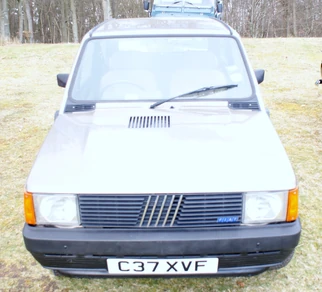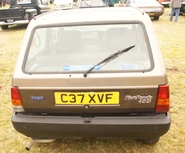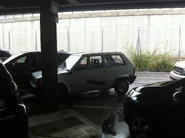
Fiat Panda
The Fiat Panda is a city car from the Italian automobile manufacturer Fiat. The first Fiat Panda was introduced in 1980, and was produced until 2003 with only a few changes. It is now sometimes referred to as the "old Panda". The second model, launched in 2003, is sometimes referred to "New Panda" or "Nuova Panda" (in Italian), and was the European Car of the Year in 2004. The third generation debut at Frankfurt Motor Show in September 2011 will be assembled in Italy at Pomigliano d'Arco. In over 31 years Fiat has sold over 6.5 million Pandas globally.
1st generation (1980–2003)[]
Introduced in 1980, the Panda was designed as a modern day "peasant car": a cheap, basic, no-frills utility vehicle, that would be easy to use and maintain. It can be seen as a later approach to the same niche which the Citroën 2CV and Renault 4 were designed to serve. Designed by Giorgetto Giugiaro, the Panda was noted for its box-like styling, which would become the house style for Fiats throughout the 1980s.
Mechanically the first Pandas borrowed heavily from the Fiat parts bin. Engines and transmissions came from the Fiat 127 and, in certain territories, the air-cooled 652 cc two-cylinder powerplant from the Fiat 126. The plan for a mechanically simple car was also evident in the rear suspension, which used a dead axle suspended on leaf springs. Later versions of the car added various mechanical improvements but this spirit of robust simplicity was adhered to throughout the life of the model.
Many design features reflect the Panda's utilitarian practicality. Examples include a seven-position adjustable rear seat which could be folded flat to make a bed, or folded into a V shape to support awkward loads, or easily and quickly removed altogether to increase the overall load space. The first Pandas also featured removable, washable seat covers, door trims and dashboard cover, and all the glass panels were flat making replacements easy and cheap to produce. Much like its earlier French counterparts the Panda could be specified with a two piece roll forward canvas roof.
The original Panda met with great success across Europe, polling 2nd in the 1981 European Car of the Year awards in its first full year of production (pipped to first place by the Ford Escort Mark III) and staying in production in some regions until May 2003.
The first Pandas came fitted with either a two-cylinder air-cooled 652 cc engine (derived from that of the 126) — the Panda 30 or a four-cylinder water-cooled engine displacing 903 cc (from the 127) — the Panda 45. In September 1982 Fiat added another engine to the line-up: the Panda 34 used an 843 cc water-cooled unit, derived from that in the 850.
Fiat launched the Panda 45 Super at the Paris Motorshow later in 1982, with previous specification models continuing as the "Comfort" trim. The Super offered numerous improvements, most significant being the availability of a five-speed gearbox as well as improved trim. There were minor styling changes to the Super including the introduction of Fiat's new black plastic "corporate" grille with five diagonal silver bars. The earlier grille design (metal with slots on the left for ventilation) continued on the Comfort models until the next major revision of the line-up. A 30 Super was added to the range in February 1983, offering the Super trim combined with the smaller engine.
The Panda 4x4 was launched in June 1983, it was powered by a 965 cc engine with 48 bhp (36 kW) derived from that in the Autobianchi A112. Known simply as the Panda 4x4, this model was the first small, transverse-engined production car to have a 4WD system. The system itself was manually selectable, with an ultra-low first gear. Under normal (on-road) conditions starting was from second, with the fifth gear having the same ratio as fourth in the normal Panda. Austrian company Steyr-Puch supplied the entire drivetrain (clutch, gearbox, power take-off, three-piece propshaft, rear axle including differential and brakes) to the plant at Termini Imerese where it was fitted to the reinforced bodyshell.
Minor revisions in November 1984 saw the range renamed "L", "CL", and "S". Specifications and detailing were modified across the range including the adoption of the Fiat corporate grille across all versions. Mechanically, however, the cars remained largely unchanged.
1st facelift (1986–1991)[]
First facelift of the original PandaIn January 1986 the Panda received a facelift and a series of significant mechanical improvements. The 652 cc air-cooled 2-cyl engine was replaced by a 769 cc (34 bhp) water-cooled 4-cyl unit, and the 903 cc by a 999 cc (45 bhp or 50 bhp (37 kW) in the 4x4) unit. Both new engines were from Fiat's new FIRE family of 4-cylinder water-cooled powerplants with a single overhead camshaft. The rear suspension was also upgraded, the rear leaf springs being replaced by a more modern independent suspension system using a rigid rear axle (known as the 'Omega' axle) with a central mounting and coil springs. The 4x4 retained the old leaf sprung set-up, presumably to avoid having to redesign the entire 4WD system.
Improvements were also made to the interior and the structure. The body was strengthened and fully galvanised on later models, virtually eliminating the earlier car's strong tendency to rust. The rear panel design was also revamped to include flared arches that mirrored those of the front wings, replacing the un-sculpted style seen on earlier models, and the doors received a slight redesign with the earlier car's quarter light windows being removed and replaced by a full width roll-down window. The bottom seam of the Mk II's doors unfortunately retained much the earlier car's susceptibility to rust. In ascending order of specification and cost, the revised range was as follows: 750L, 750CL, 750S, 1000CL, 1000S, 4x4.
April 1986 saw the introduction of a 1301 cc diesel engine with 37 bhp (a detuned 127/Uno unit). Fitted as standard with a five-speed gearbox it was only available in the basic "L" trim. A van variant of the Panda was also introduced, with both petrol and diesel engines. The van was basically a standard Panda without rear seats. The rear windows were replaced with plastic blanking panels and a small (always black) plastic extension with side hinged doors was fitted instead of the usual hatchback tailgate. Neither the van nor the diesel were available in right hand drive markets.
In 1987, a new entry-level model badged "Panda Young" was added to the range. This was essentially an L spec car with a 769 cc OHV engine based on the old 903 cc push-rod engine and producing the same 34 bhp (25 kW) as the more sophisticated 769 cc FIRE unit. The Panda 4x4 Sisley limited edition was also released; this was based on the standard 4x4, but came with metallic paint, inclinometer, sunroof, white painted wheels, roof rack, headlamp washers, bonnet scoop, "Sisley" badging and trim. Although originally limited to the production of only 500, in 1989 the Sisley model became a permanent model due to its popularity.


